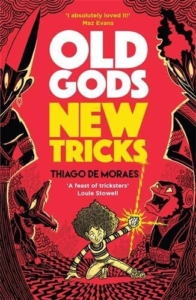
Old Gods, New Stories: an interview with Thiago de Moraes
Fiona Noble talks to Thiago de Moraes about his new book, Old Gods New Tricks.
 ‘I’ve been obsessed with mythology since I was a very young child,’ Thiago de Moraes tells me. As a child in Brazil, he pored over his parents’ vast book collection, discovering everything from West African mythology to tales of Norse and Hindu gods, to Old Testament fire and brimstone. ‘I spent my whole childhood reading that stuff, much of which was clearly inappropriate,’ he laughs. His passion for the subject is infectious. Our conversation is peppered with snippets of favourite myths; no wonder then that his latest book Old Gods New Tricks, published by David Fickling Books, brings together mythology from across the world.
‘I’ve been obsessed with mythology since I was a very young child,’ Thiago de Moraes tells me. As a child in Brazil, he pored over his parents’ vast book collection, discovering everything from West African mythology to tales of Norse and Hindu gods, to Old Testament fire and brimstone. ‘I spent my whole childhood reading that stuff, much of which was clearly inappropriate,’ he laughs. His passion for the subject is infectious. Our conversation is peppered with snippets of favourite myths; no wonder then that his latest book Old Gods New Tricks, published by David Fickling Books, brings together mythology from across the world.
Thiago’s love of drawing and creating stories was also fuelled by French comics like Asterix and Tintin, sent by his mother’s French family. After studying graphic design, he moved to the UK with his wife, Ana, in his early 20s, working in advertising and eventually becoming an Art Director and running his own agency. Thiago and Ana initially created a few picture books together for fun. The Zoomer’s Handbook was published by Andersen Press in 2015, and this sparked the idea of children’s books as a career. In 2018 came Myth Atlas, first in a long-running partnership with publisher Alison Green, an intricately illustrated non-fiction book exploring how 12 cultures saw the world. ‘One thing that always struck me was a lot of cultures had oral stories and sculptures but few drawings of what things actually looked like,’ Thiago recalls. ‘Then I found out some of the descriptions are completely physically impossible to put together…’ He spent 18 months researching and creating the book, which sold in over 20 languages and enabled him to become a full-time writer and illustrator. Two sequels followed – History Atlas and Discovery Atlas – along with his first foray into fiction, A Mummy Ate My Homework, and The Age of Stone, a comic strip in The Phoenix magazine, but he yearned to return to mythology.
During the first lockdown his wife suggested that he write a book about trickster gods, an idea that gradually took hold in his mind. In Old Gods New Tricks, the world is suddenly plunged into darkness when electricity disappears, an intriguing ‘reverse engineering’ of the Prometheus myth. ‘If somebody stole fire from the gods and gave it to humanity, what happens if they take it away?’ he explains. ‘Or in our modern world, what happens if the power goes?’ Writing towards the end of lockdown, the concept echoes that sense of something very fundamental going wrong in the world. ‘I like the idea,’ he continues, ‘that there’s stuff around that maybe operates in places and in ways that we don’t see.’ When the power goes out, a young girl, the gloriously resolute Trixie, immediately suspects divine intervention and embarks on a quest to recruit trickster gods from across the world to bring back the light. In a fast-paced and very funny adventure we meet Exu, of the Orisha, Loki from Northern Europe, Coyote from Central America, Maui from Polynesia and Sun Wukong from Asian folktales. ‘The thing that is fascinating about tricksters,’ Thiago remarks, ‘is that they are usually the catalysts of creation in mythology. They are the characters that change social rules and the orders of society, that bring fire from the gods and give it to humanity.’ If the typical god represents an individual notion like strength, war, love or motherhood, these maverick gods are a little different. ‘I always found them the most fascinating group of gods,’ he admits, ‘not because they are mischievous but because I think they are the closest to us. They have more facets to them.’
Then, he says, the hard part began. ‘If you write a book full of clever stratagems, then you have to come up with clever stratagems. When Trixie recruits each trickster, I wanted her to, in most cases, reverse engineer a trick they have done.’ The book cleverly weaves myths into the action and creates the distinct character of each trickster with strong dialogue. Mythologies, of course, contain multiple versions of each god which Thiago used ‘as a place to jump from’ in shaping his characters. A factual index is also included at the back of the book, to further inspire a love of myths in his readers. Although the book includes some black and white illustrations, Old Gods New Tricks is, he notes, the book he has written the most and drawn the least. ‘I wanted things to be a bit more considered, to spend more time on each individual illustration and maybe not draw Loki 50 times, but 3 times, and make them count.’
The world of mythology is notoriously bloody and violent. What challenges does this present in creating books for children? ‘We do live in a world where there is a lot of cushioning,’ Thiago says, ‘but there is a brutality which is scarring, borne out of a lack of kindness or compassion.’ Although he avoids certain topics, he suspects that actual gore itself is less frightening for children. ‘There are things in the book which might be a bit scary but I think it’s important to show that sometimes, most of the time, those who have power wield it without concern for those who haven’t.’
Fiona Noble is a books journalist and reviewer, specialising in children’s and YA literature, for publications including The Bookseller and The Observer.
Old Gods New Tricks is published by David Fickling Books, 978-1788452953, £7.99 pbk
Other books mentioned:
The Zoomer’s Handbook, Andersen Press, 978-1783442157, £6.99 pbk
Myth Atlas, Alison Green Books, 978-1407178134, £18.99 hbk
History Atlas, Alison Green Books, 978-1407189239, £20.00 hbk
Discovery Atlas, Alison Green Books, 978-0702300516, £20.00 (September 2023)
A Mummy Ate My Homework, Scholastic, 978-1407194929, £8.99 pbk
The Age of Stone, The Phoenix Comic




